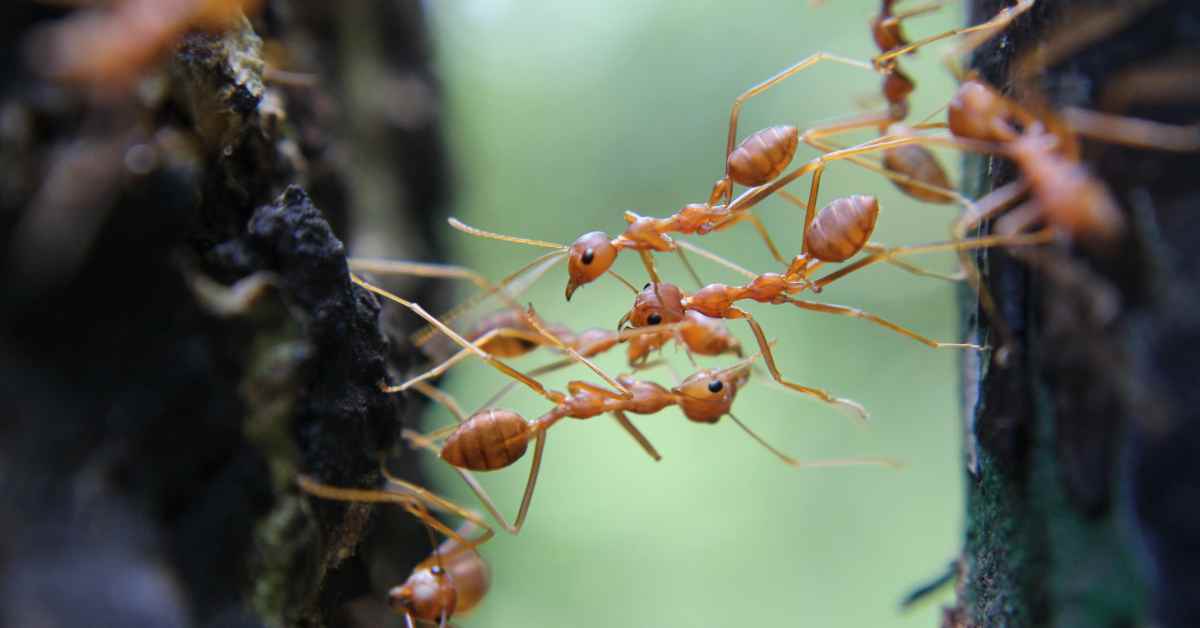Ants live in groups or colonies and make collective decisions, as they are social insects. It is a survival strategy because they cannot survive in solitary conditions and depend on each other.
Ants exhibit collective decision making during foraging, nest construction, raft building, bridge formation, food transportation, and nest relocation. Moreover, the sewing of leaves by weaver ants, and burying of dead fellows also show this behavior, which is a survival strategy in ants.
There is a division of labor among the colony members, which means their entire colony serves as a single organism. So, they coordinate and cooperate to ensure the survival of the colony.
Collective decision-making in ants makes them powerful insects as they can live and defend better than solitary insects. Their efficiency improves when they engage in any activity collectively.
Bridge formation
In 2023, Daniele Carlesso and some other scientists from Macquarie University researched the collective behavior of weaver ants as they form chains by linking bodies.
Most colony members participate in the chain formation process as this action facilitates foraging members to cross vertical gaps and reach areas without considering gaps as barriers.
Kai McNamee recently published an article on the official site of National Public Radio (NPR) about the collective intelligence of army ants as they build bridges to move across gaps.
A biologist, Isabella Muratore, mentioned the bridge-forming behavior of army ants in that article and talked about their strategies to bridge the gap collectively.
She added that it looks like a shortcut to overcome the barrier in their path instead of returning to the nest when their goal is to reach the destination on the other side of the gap.
Raft building
In 2011, David Hu and other researchers from the Georgia Institute of Technology studied the raft-building behavior of fire ants, a combined effort of the entire colony.
David Hu worked as a professor of engineering at this university and studied their collective behavior. They make a big, waterproof raft-like structure to avoid flooding risks.
Researchers scanned the frozen rafts of fire ants in a CT scan machine to see inside the bigger structure for deeper insights into the arrangement and orientation.
Professor David Hu said it looked like a warehouse from the inside when he scanned the raft and found that almost 99% of the fire ants were attached using their legs or claws.
Foraging behavior
Ants opportunistically switch their behavior from individual to collective and vice versa, as it depends on external stimuli.
In 2022, Yukari Tamura from Hiroshima University and other researchers studied Lasius japonica and its foraging action in different conditions.
They investigated that ants followed a circular path of pheromones created by the researchers that did not lead to a food source. Their attitude changed when the food was placed at the end of the path.
This circular path started from their nest and ended there, too, so Yukari Tamura and his fellows observed that ants broke the circular trail and found the shortest route to reach the food.
It indicated that they changed their foraging behavior and kept their interests as a priority, which was a food source in that case. So, they broke the trail and changed the direction of movement.
However, other ants also began to move on the shortest route and changed their trail direction within a short time, indicating their mutual interests.
Relocation of nests
In 2022, Roman Meitav wrote an article in The Jerusalem Post about the collective behavior of ants that act like a neural network when they have to make a decision.
He studied their colonial behavior at high temperatures and revealed that external stimuli directly impact their decisions. An increased temperature leads to the evacuation of nests to avoid overheating.
All of the colony members begin to move out of their nests when they detect excessive warmth and suffocation, which is an example of a collective decision by the colony.
In addition, nest relocation is a collective behavior, as some scientists at Arizona State University studied in 2012. They found that all Temnothorax rugatulus ants collectively decide nesting spots.
An individual ant is not responsible for choosing the shelter, as they mutually decide about the next location after disturbance to their older nests.
It was observed in the previous research that the colonies can compare nest qualities and find the most potential nesting spot, having food and water sources.
Nest construction by sewing leaves
Weaver ants also show collective behavior during nest construction, as they gather leaves and sew them together using larval silk, as studied by Robert J. Marquis in 2007.
He called weaver ants ecosystem engineers, as these create leaf ties together by overlapping the leaves and using larval silk to sew them together.
Moreover, the worker ants hold larvae in their jaws and use the silk they produce to weave the leaves, forming an arboreal nest.
Food transportation
In 2021, Nir S. Gov and some other researchers published a paper about this sequential decision-making behavior of longhorn crazy ants during food transportation.
They rely on each other to carry a large load that cannot transfer to their nests individually. They carried out experiments with different load weights and noted their response.
They concluded that the number of longhorn crazy ants increases with the increase in weight, as it supports easier and quicker transfer of the heavy load to the nest.
Dead fellows burying
Ants also exhibit collective behavior at the time of burying their fellows, as they do not leave their dead ones on the ground. They carry corpses on their backs and take them to graveyards.
Their graveyards are specific spots close to nests where they stack dead fellows one over another. They bury fellows with combined effort, as individual ants cannot drag a dead body to the midden.
Related Articles:


